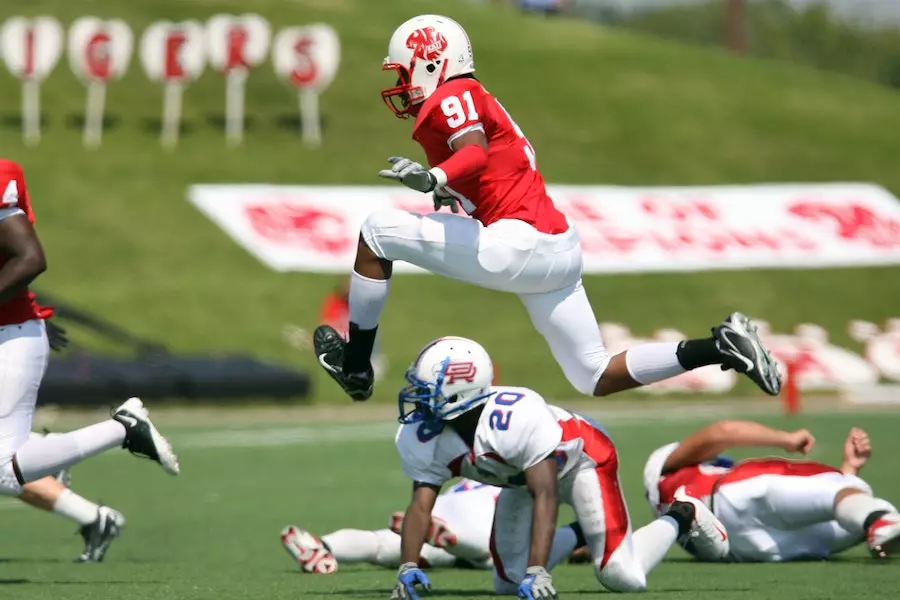
In fantasy football, draft day is perhaps the most important day of the season. Before the season, you draft your players onto teams that you “own.” You track your play as you follow the actual NFL.
You’re making a virtual roster of real NFL players, and then you compete against the rosters of other people based on the real game stats of players. A traditional league will last for a season, and there are daily leagues where you might draft a new set of players every week.
Leading up to a draft, you’ll do your research and prepare with everything from fantasy football videos and articles to podcasts.
The wins and losses of the teams themselves are fairly irrelevant. Instead, it’s all about your individual players. The players accrue points through things like catches, yards, and touchdowns.
Just before the start of the season, you and the other owners in your league hold a draft, picking the players you all want on your team. There are usually 10 or 12 owners in a league. Every player can only be on one team in your league. Then, after the draft and as the season goes on, you can adjust your roster by picking up players who weren’t drafted, dropping players you don’t want, and trading.
For every week of the regular season, you’re choosing a group of players who are your starters.
With all that being said, you can see how your draft is going to be what plays a big role in the success of your fantasy football season, and the following are things to know.
1. Planning The Draft
One of the toughest parts of the much-anticipated draft for a lot of people who play fantasy football is finding a time that’s going to work for everyone. The aim is to have the draft as near to the start of the regular season as possible.
In a typical year, the third weekend of the preseason is when a lot of leagues hold their draft because it’s the final week starters play.
The reason the draft needs to be scheduled as close to the season’s start as is so you can be up-to-date.
You’ll have seen new players, and you’ll come prepared with information.
2. Draft Order
There are a lot of ways a league can approach the draft order. There are apps and platforms that will randomize it for you, which can help prevent too many hard feelings.
Some leagues like to be creative in their draft order, though.
If your league has existed for a while, then you might base your draft order on the finish from the past year. The team with the worst record can get top pick in the draft, replicating the NFL.
3. Draft For Value
If you’re new to fantasy football, you may not have heard the phrase draft for value. If you’re not completely new, you’ve probably heard it a lot.
So what does it mean?
In your draft, you have to find value. If you’re new to fantasy football, you might think this means that you’re going to choose the names you’re familiar with, like Tom Brady. You could think that since Tom Brady, at least last season was one of the highest-scoring players in fantasy and real football, you’re going to get him, and it’ll be great.
There’s an issue here.
A quarterback is one of those positions where there’s a distinction between fantasy and real football. It’s easy to find a quarterback in fantasy, and the top 12 in scoring average during the last season posted at least 18.8 points in each game.
On the other hand, only three running backs scored at least that many points per game. You’ll have to start a minimum of two running backs each week and just one quarterback. This all means that a running back is more valuable because of supply and demand.
It’s harder to find quality running backs as well as wide receivers and tight ends compared to a position like a quarterback, so these are the players you want to prioritize early on.
4. Focus On Running Backs
The reason running backs are so important in fantasy football is something we started talking about above. A good draft strategy is going to be built on running backs in almost all cases of fantasy football.
There is a lot of value in an elite running back because of the consistency in the lack of available running backs and the fact that elite running backs have a better chance in any week to score a touchdown than any other position.
When you’re drafting, also draft a backup for your running back. You’re then protecting yourself against the likelihood of your star running back getting hurt.
5. Be Patient About Quarterbacks
If you haven’t played fantasy football before, you might not realize that experts will tell you in your draft strategy, don’t rush into drafting a quarterback. Again, there are just so many quality quarterbacks in football that you don’t have to try and get one right off the bat.
6. Be Cautious About Overvaluing A Rookie
You might have your eye on a rookie, but don’t overvalue them, and don’t draft them too early on. You might want to wait until later in the draft to take a chance on a rookie that you’re eyeing.
7. Stack Your Bench
You’ll need at least four running backs and wide receivers who are part of your lineup every week, and you can have up to five in all. These positions are, as such essential to your rosters.
If you think ahead to the potential for players who struggle in their performance, bye weeks, and injuries, you’ll realize you need a deep bench in these certain spots to carry you through rough patches.
8. Target Upside
Finally, you aren’t rewarded in fantasy football for finishing in the middle of the pack. You need a roster with true upside. Keep the upside in mind when you’re drafting.
An upside player is one who has the potential to exceed expectations, giving you a lot of fantasy value. The key to upside players is that expectations about them are low, so you can wait and draft them in your late rounds, or you can add them from free agency. You, as a general manager, then don’t have to use one of your top draft picks.







